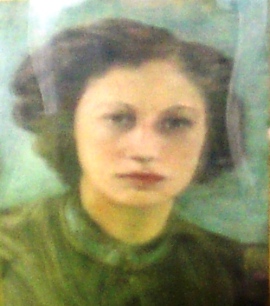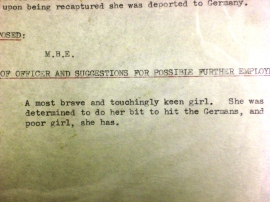Noor Inayat Khan, “Madeleine”
(Update: Jean Overton Fuller, who very kindly spoke to me about her friend Noor Inayat Khan for this article, passed away on 8 April 2009, aged 94. RIP.)
Noor Inayat Khan, known in the French resistance as “Madeleine”, served as an SOE radio operator in occup ied Paris in the summer and autumn of 1943, aged just 29.
ied Paris in the summer and autumn of 1943, aged just 29.
She was the Indian-American daughter of a Sufi mystic, raised in France, and a direct descendant of the renowned Indian ruler Tipu Sultan, “The Tiger of Mysore”.
My character Rose Arden, though of far humbler origins, is based partly on “Madeleine”, as well as on several other redoubtable women, including SOE agent Pearl Cornioley and my own grandmother-in-law, Betty Ozanich.
I first encountered Noor Inayat Khan in Leo Marks’ book “Between Silk and Cyanide”, about his wartime years as SOE’s codemaster. Marks described her as a radiant and unearthly young woman, brought up never to lie, with whom he seems to have fallen a little in love as he taught her coding protocols before her mission.
A writer and musician in Paris before the war, Noor Inayat Khan made an indelible impression on all those she met — raising the question, for some, of whether she should ever have been sent on a mission requiring an affinity for anonymity and subterfuge that was not her own. Yet, as official SOE historian MRD Foot puts it, writing of such decisions: “The work had to be done, and there was nobody else to send.”
Jean Overton Fuller, her close friend and first biographer, kindly agreed to meet me in May 2007 to talk about wartime London, and particularly about Noor. To hear Ms Fuller talking to me about Noor Inayat Khan’s last night in London before flying into wartime France, click here .
When I asked Ms Fuller about a detail of Noor’s appearance, she asked me to wait a moment, and then went upstairs. She came down carrying a remarkable portrait of Noor that her mother, Violet Overton Fuller, had painted, after meeting Noor just a few months before her fateful mission.
For several critical we eks in the autumn of 1943, as Gestapo eavesdroppers tracked her transmissions and SOE circuits collapsed about her, “Madeleine” served as the most important radio link — at times even the only one — between Paris and SOE’s French section headquarters in London: their eyes and ears in the French capital.
eks in the autumn of 1943, as Gestapo eavesdroppers tracked her transmissions and SOE circuits collapsed about her, “Madeleine” served as the most important radio link — at times even the only one — between Paris and SOE’s French section headquarters in London: their eyes and ears in the French capital.
Then she was betrayed, and captured.
After two unsuccessful escape attempts from Gestapo HQ on Avenue Foch, she was sent to prison in Germany under a “Nacht und Nebel” order — meaning “Night and Fog”: she was simply to disappear, her fate never to be recorded.
Details did emerge, though. For months, “Madeleine” was kept in chains and solitary confinement in a prison in Karlsruhe. Then she was taken by train to Dachau concentration camp, severely beaten and executed. Her last word, according to one account, was “Liberty.”
 A prolific author who kept writing well into her 90s, Jean Overton Fuller tracked down many of her friend’s fellow agents, captors and interrogators after the war to build up a picture of Noor Inayat Khan’s final months, eventually publishing a best-selling biography.
A prolific author who kept writing well into her 90s, Jean Overton Fuller tracked down many of her friend’s fellow agents, captors and interrogators after the war to build up a picture of Noor Inayat Khan’s final months, eventually publishing a best-selling biography.
To learn more about Noor Inayat Khan’s life, read this archived BBC article, or check out this more recent biography by Shrabani Basu.
(Picture credits: SOE file photo of Noor Inayat Khan, photographed by Martin Langfield at National Archives, Kew; Oil painting of Noor Inayat Khan by Violet Overton Fuller, photographed by Martin Langfield; ; extract from Noor Inayat Khan’s SOE file HS9/836/5 at National Archives, Kew, photographed by Martin Langfield)


